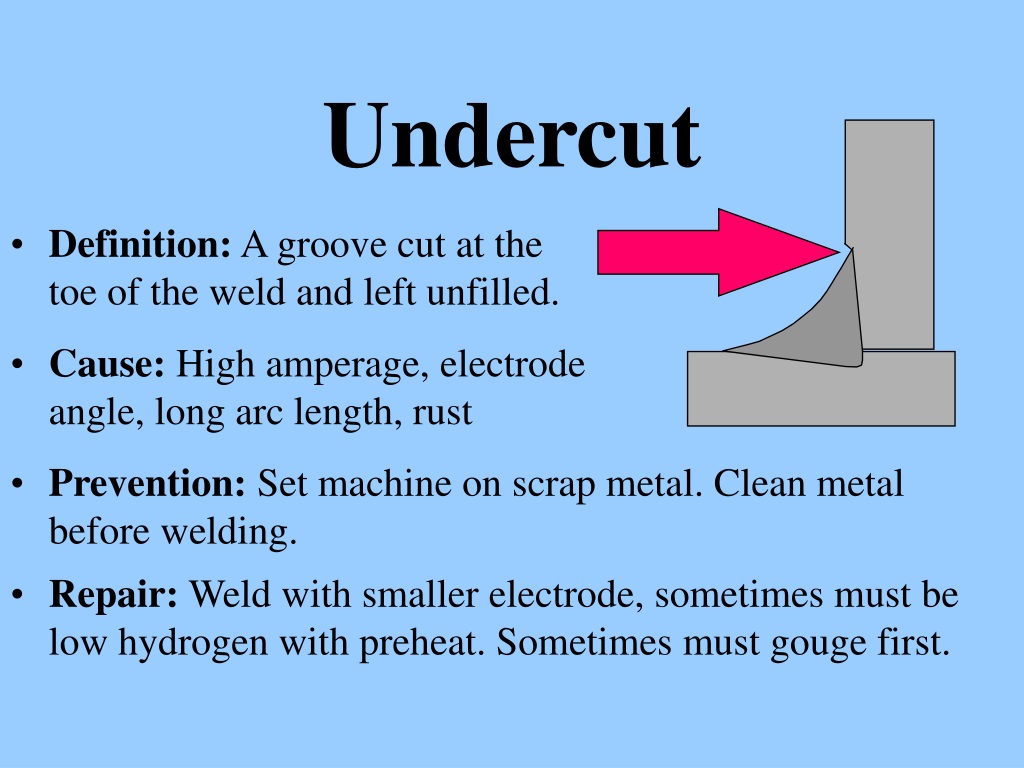Efficient Ways to Prevent Weld Undercut in Your Welding Tasks
Wiki Article
Understanding the Art of Welding: Exactly How to Stay Clear Of Undercut Welding Issues for Flawless Fabrication Outcomes
By recognizing the origin creates of undercut welding and implementing effective techniques to prevent it, welders can elevate their craft to new levels of excellence. In the pursuit of flawless fabrication results, mastering the art of welding to avoid undercut issues is not just a skill but a necessity for those striving for excellence in their job.Comprehending Undercut Welding

To stop undercut welding, welders ought to make certain proper welding criteria, such as adjusting the present, voltage, traveling speed, and preserving the proper electrode angle. Additionally, utilizing the ideal welding technique for the details joint configuration is necessary. Using weaving motions or backstepping strategies can help guarantee correct weld steel deposition and reduce the possibility of undercut development. Normal examination of welds during and after the welding process is likewise important to capture any kind of undercut very early and make necessary adjustments to avoid more problems. Preventing weld undercut. By understanding the root causes of undercut welding and carrying out safety nets, welders can attain top quality, structurally sound welds.
Sources Of Undercut in Welding
Comprehending the aspects that add to undercut in welding is important for welders to generate premium, structurally sound welds. Undercutting happens when the weld metal does not correctly fill up the groove formed in between the base steel and the previously transferred weld steel. A number of aspects can result in undercut in welding. One common reason is excessive warm input. Welding at heats for extended periods can cause the base metal melting even more than desired, resulting in damage. Insufficient welding current or wrong welding speed can also add to undercut. Not enough current may not provide adequate warm to melt the base and filler steels effectively, while extreme speed can protect against appropriate combination, causing undercut. Furthermore, inappropriate electrode angles or inaccurate torch control techniques can produce locations of low weld metal deposition, promoting undercut. Understanding these causes and implementing appropriate welding techniques can aid avoid damaging issues, making certain durable and solid welds.Methods to stop Undercutting

To minimize the threat of undercutting in welding, welders can employ strategic welding methods focused on boosting the quality and stability of the weld joints. One effective approach is to adjust the welding criteria, such as voltage, present, and take a trip speed, to make certain proper warmth input and deposition. Maintaining a suitable electrode angle and ensuring constant traveling speed can additionally help prevent undercut. Furthermore, making use of the proper welding strategy for the details joint arrangement, such as weave or stringer beads, can add to reducing undercutting. Preventing weld undercut.
Moreover, appropriate joint preparation, consisting of guaranteeing clean base products without pollutants and using the ideal welding consumables, is important in stopping undercut problems. Using back-step welding methods and controlling the weld grain profile can additionally assist disperse warm evenly and decrease the danger of undercut. Routine evaluation of the weld joint throughout and after welding, in addition to executing top quality assurance actions, can assist in discovering and dealing with damaging Home Page concerns immediately. By implementing these strategies vigilantly, welders can attain flawless construction results with marginal undercut problems.
Relevance of Proper Welding Specifications
Choosing and keeping appropriate welding parameters is essential for accomplishing successful welds with minimal issues. Welding criteria refer to variables such as voltage, current, travel speed, electrode angle, and protecting gas circulation price that straight check that influence the welding procedure. These criteria must be thoroughly changed based on the type of material being welded, its thickness, and the welding method utilized.Appropriate welding specifications guarantee the ideal quantity of warm is applied to melt the base metals and filler material uniformly. If the parameters are established expensive, it can bring about too much warmth input, creating spatter, distortion, or burn-through. On the various other hand, if the specifications are as well low, incomplete fusion, absence of infiltration, or damaging might happen.
Quality Control in Welding Procedures

Conclusion
In conclusion, understanding the art of welding needs an extensive understanding of undercut welding, its causes, and techniques to stop it. By making sure proper welding criteria and carrying out quality control methods, perfect fabrication outcomes can be attained. It is vital for welders to consistently pursue excellence in their welding procedures to prevent undercut issues and create high-grade welds.Undercut welding, a common issue in welding processes, takes place when the weld metal does not properly fill up the groove and leaves a groove or depression along the welded joint.To protect against undercut welding, welders must make sure proper welding criteria, such as adjusting the present, voltage, traveling speed, and preserving the proper electrode angle. Inadequate welding incorrect or present welding rate can also contribute to damage.To minimize the risk of undercutting in welding, welders can use strategic welding methods intended at boosting the quality and integrity of the weld joints.In final thought, understanding the art of welding calls for an extensive understanding of undercut welding, its reasons, and strategies to prevent it.
Report this wiki page